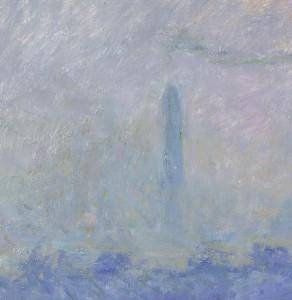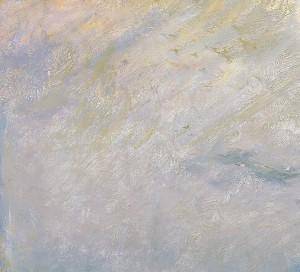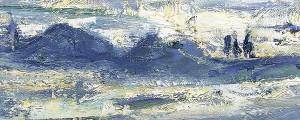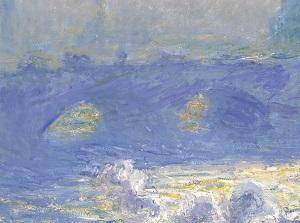Students will explore how painter Claude Monet and poet E.E. Cummings used different artistic mediums to highlight the contrasts found in a city. They will then explore various literary devices and compose a poem in the style of Cummings.
Students will be able to:
- discuss and analyze a painting for its defining characteristics, compositional qualities, and distinctive mood and atmosphere;
- read and analyze a poem by E.E. Cummings;
- draw a comparison between a painting and a poem; and
- write a poem that incorporates their observations of different art forms.
Lesson
1. Show students Waterloo Bridge and begin by giving them plenty of time to look.
2. Ask students what they see. Engage in a discussion using the following questions:
- What kind of an atmosphere do you think Monet was trying to create in this painting? How can you tell?
- How might he have created fog (different brush strokes, colors, composition choices, etc.)?
- In what ways did Monet create contrast in the painting? (He used contrasting colors—blue and orange—and he also contrasted the natural imagery of the Thames River with the industrial smokestacks in the background.)
3. Use the About the Art section to provide background information about Monet, his painting process, and his fascination with fog. Share this quotation from Monet:
“The fog in London assumes all sorts of colors; there are black, brown, yellow, green, purple fogs, and the interest in painting is to get the objects as seen through these fogs.”
4. Ask students how they think a poet might capture a similar foggy scene. What words and phrases would convey the essence of this scene? Ask students to write down descriptive words they would use in a poem to describe the scene.
5. Read E.E. Cummings’s poem Paris; This April Sunset Completely Utters by E.E. Cummings out loud twice to the class.
6. Provide some context for the poem and explain that E.E. Cummings spent a lot of time in Paris and he, like Monet, was drawn to both the natural beauty of the city as well, as its modern aspects. Cummings wrote in 1953 that in Paris, “two realms, elsewhere innately hostile, here cordially co-existed—each (by its very distinctness) intensifying the other—nor could I have possibly imagined either a loveliness so fearlessly of the moment or so nobly beautiful a timelessness.” He also described Paris as “an actual marriage of material with immaterial things.”
7. Ask students to point out examples of contrasting language in Cummings’s poem.
8. Help students notice some of Cummings’s literary techniques, such as alliteration, the repeating an initial consonant to increase the musical quality of the language. Point out the unique ways that Cummings isolates images and ideas for emphasis and breaks the conventional rules of grammar to force the reader to run words together.
9. Ask students to revisit the words they wrote down after looking at Monet’s Waterloo Bridge. Have them write a poem in Cummings’s style about the Waterloo Bridge. They could follow Cummings’s structure: Begin with the name of the city, the time of day, and name of an architectural structure (Waterloo Bridge); then describe the structure and scene and explain what happens when the time of day or weather changes.
10. Encourage students to highlight the contrasts in Monet’s painting and to experiment with Cummings’s signature literary techniques.
11. After writing for about 15 minutes, ask students to meet with a partner to share what they have so far. Tell them to give feedback on what is clear, what they could improve, and what they love.
12. Allow students plenty of time to finish their poems, then give them a chance to share with the class.
Materials
- Pencils/pens and paper or computers for composing the poems
- Copies of the poem Paris; This April Sunset Completely Utters by E.E. Cummings
- About the Art section on Waterloo Bridge
- One color copy of the painting for every four children, or the ability to project the image onto a wall or screen
Standards
- Visual Arts
- Invent and Discover to Create
- Observe and Learn to Comprehend
- Relate and Connect to Transfer
- Envision and Critique to Reflect
- Language Arts
- Oral Expression and Listening
- Collaboration
- Critical Thinking & Reasoning
- Information Literacy
- Invention
- Self-Direction
Waterloo Bridge, Sunlight Effect (Effet de Soleil)
- Claude Monet, French, 1840-1926
- Born: Paris, France
The most widely known French Impressionist and leader of that movement, Claude Monet [moe-NAY] was born in Paris and grew up on the Normandy coast. His father was a wholesale grocer, and after his mother died when he was 17, an aunt encouraged him in his efforts to become an artist. With a local reputation as a caricaturist, he attracted the interest of landscape painter Eugene Boudin [boh-DAN], who introduced the young artist to plein-air painting. Plein-air is French for “open air” and refers to paintings created outdoors.
In the 1860s, Monet joined a group of young artists who began to challenge the rules for making good paintings. They had so much trouble getting their work exhibited that they created their own independent exhibition, which yielded only ridicule and a sarcastic label for the group of artists. That label—derived from Monet’s painting, Impression, Sunrise of 1874—stuck, and produced the moniker of “Impressionists” for the group. Impressionists were initially criticized for their unworthy subjects, unrealistic colors, garish color combinations, and loose, seemingly unfinished brushwork.
Like many other Impressionists, Monet had little success in his early years. He most often chose to paint landscapes and leisure activities—everyday activities of modern Paris that were considered to be unworthy subjects for art, compared to the highly respected religious and mythological subjects. With his paintings, Monet strove to capture a fleeting moment by rendering the nuances of light and color. He wanted to depict the feeling or sensation of a scene, rather than the objects within the composition. As public opinion of Impressionism began to turn in the mid-1880s, Monet’s paintings began to sell well, and by the turn of the century, he was one of the world’s wealthiest artists.
"I so love London! But I love it only in winter. It’s nice in summer with its parks, but nothing like it is in winter with the fog, for without the fog London wouldn’t be a beautiful city. It’s the fog that gives it its magnificent breadth. Those massive, regular blocks become grandiose within that mysterious cloak." -Monet
The constantly changing light and atmospheric effects of the fog in London inspired Monet to proclaim, “No country could be more extraordinary for a painter.” Painting from the balcony of his suite at the Savoy Hotel on the Thames [tehms] River, Monet could hardly keep up with the shifting conditions. As he worked, he kept all the paintings he’d begun (sometimes dozens) close at hand. As the light changed, he’d switch out the canvas he was working on for another, frantically trying to find the one that best matched what he was currently seeing. He wrote his Paris dealer, “I can’t send you a single canvas, because, for the work I am doing, it is indispensable to have all of them before my eyes.” Monet brought the unfinished canvases back home and spent years reworking them in his studio. He made a total of 41 paintings of Waterloo Bridge.
Details

Modern London
Like many Impressionists, Monet was drawn to scenes and elements of everyday life, so it’s not surprising that he was interested in the modern parts of London. On the river we see commercial shipping boats. Across the bridge we see the smokestacks of smog-producing factories.

Pollution
In winter, industrial smokestacks, commercial boats, and chimneys everywhere made great clouds of coal smoke that mixed with mist from the river. The resulting smog was like a veil over the city that changed colors with the light. Most people thought it quite dirty, smelly, and disgusting, but Monet found it wonderful.

Colors in the Haze
While other painters would depict London as a drab, gray, urban space, Monet observed how the fog changed colors depending on the light. Notice the lilac, pink, and pale olive colors in the mists. As Monet explained, “The fog in London assumes all sorts of colors; there are black, brown, yellow, green, purple fogs, and the interest in painting is to get the objects as seen through these fogs.”

Layers of Paint
Monet’s first layers of paint were very thin, with thicker areas developing as he continued to add many layers and rework the surface.

Movement
Although the scene may initially appear very still, notice all the elements suggesting movement: smoke pouring from the smokestacks, clouds, boats, traffic on the bridge, the river.

No Black
Monet felt that black had a dulling effect, so instead of black, he used a color’s complement to darken an area. For example, to darken something blue, he would add some orange or red.

Repeated Shapes
Repeated shapes—the circular puffs of smoke from the factories and boats, and the round arches of the Waterloo Bridge—are evidence that Monet was selective in what he included and where he placed it.

Waterloo Bridge
When Waterloo Bridge opened in 1817 it acted as a social division. The elegant north side of the Thames River, where the Savoy Hotel was located, was populated with large buildings and public gardens. The south side, in contrast, was the home of industry. The bridge that Monet painted was torn down in 1934 because of unstable foundations and traffic bottlenecks. The new bridge opened in 1945 and remains in use today.
Funding for object education resources provided by a grant from the Morgridge Family Foundation. Additional funding provided by the William Randolph Hearst Endowment for Education Programs, and Xcel Energy Foundation. We thank our colleagues at the University of Denver Morgridge College of Education.
The images on this page are intended for classroom use only and may not be reproduced for other reasons without the permission of the Denver Art Museum. This object may not currently be on display at the museum.





